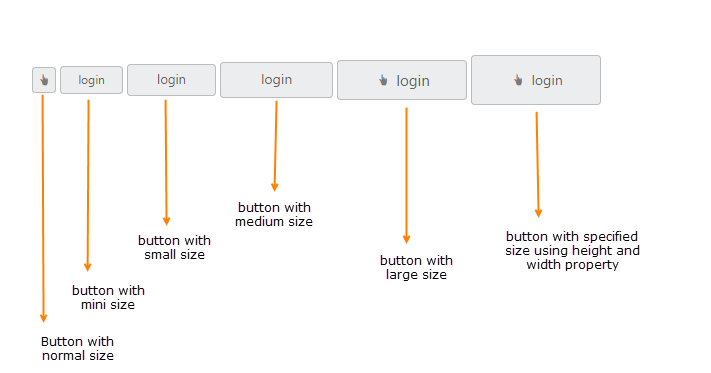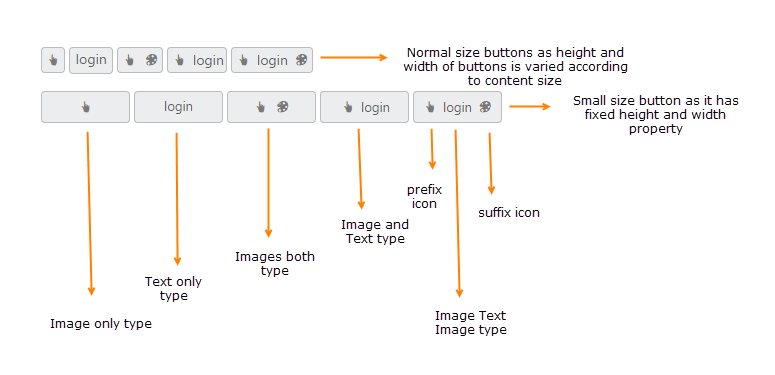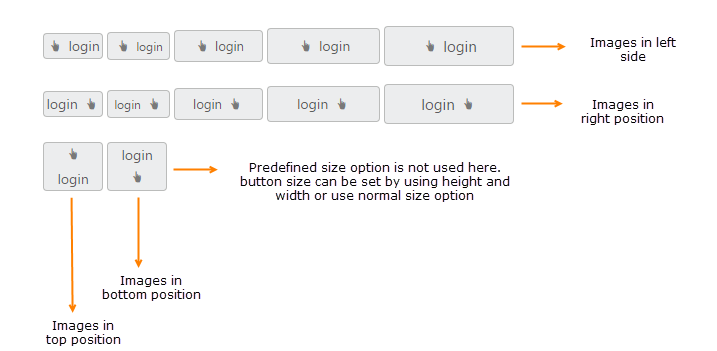Easy Customization
6 Feb 201824 minutes to read
Button is used in all applications. Button size, content and content location is varied according to each application. Here you can see some customizable option for button that can perform easily.
Button Size
You can render the button in different sizes. Here, you have some predefined size options for rendering a button with different sizes in easiest way. Each size option has different height and width. Mainly it avoids the complexity in rendering button with complex CSS class.
List of predefined button size
| Button Types | Description |
|---|---|
| Normal | Creates button with content size. |
| Mini | Creates button with Built-in mini size height, width specified. |
| Small | Creates button with Built-in small size height, width specified. |
| Medium | Creates button with Built-in medium size height, width specified. |
| Large | Creates button with Built-in large size height, width specified. |
Apart from the above mentioned predefined size option, you can set your own width and height for button using height and width property.
The following steps explains you the details about rendering the button with different size options.
In the HTML page, add the following button elements to configure button widget.
<button id="button_normal">login</button>
<button id="button_mini">login</button>
<button id="button_small">login</button>
<button id="button_medium">login</button>
<button id="button_large">login</button>
<button id="button_custom">login</button>//Here size property is used to render the button in different sizes
$(function () {
$("#button_normal").ejButton({
//normal size type is used
size: "normal",
showRoundedCorner: true,
contentType: "imageonly",
prefixIcon: "e-icon e-handup"
});
$("#button_mini").ejButton({
showRoundedCorner: true,
//mini size type is used
size: "mini"
});
$("#button_small").ejButton({
showRoundedCorner: true,
//small size type is used
size: "small"
});
$("#button_medium").ejButton({
showRoundedCorner: true,
//medium size type is used
size: "medium"
});
$("#button_large").ejButton({
//large size type is used
size: "large",
showRoundedCorner: true,
contentType: "textandimage",
prefixIcon: "e-icon e-handup"
});
$("#button_custom").ejButton({
//button with user given height and width
height: 50,
width: 130,
showRoundedCorner: true,
contentType: "textandimage",
prefixIcon: "e-icon e-handup"
});
});Execute the above code to render the following output.

Content Type
The content of the Button is mainly text and images. Instead of using complex CSS classes to render Button with different content types, you can use some predefined content type options provided for button control. Using this content types you can easily add different types of content for button. Button supports the following content types.
List of content types for button
| Content Types | Description |
|---|---|
| TextOnly | Supports only for text content only. |
| ImageOnly | Supports only for image content only |
| ImageBoth | Supports image for both ends of the button. |
| TextAndImage | Supports image with the text content. |
| ImageTextImage | Supports image with both ends and middle in text. |
Prefix and Suffix icons
Icons inside the Button is added easily using prefixIcon and suffixIcon property. Location of the icon in button is a necessary thing and you can easily customize it using the following mentioned options.
Button control also supports the Built-in icon libraries. The ej.widgets.core.min.css contains definitions for important icons that can be used in buttons. Simply you can use these Built-in icons by mentioning the icon class name as value in prefixIcon and suffixIcon property. You can use any font icons that are defined in ej.widgets.core.min.css. It avoids the complexity in specifying icon using sprite image and CSS.
For example the following mentioned Built-in CSS class are used to show the font icons that is used by media player.
- e-mediaback
- e-mediaforward
- e-medianext
- e-mediaprev
- e-mediaeject
- e-mediaclose
- e-mediapause
- e-mediaplay
Prefix Icon
It inserts the icon at the starting position of button. After this prefix icon, you can use text or suffix icon.
Suffix Icon
It inserts the icon at the ending position of button. Before this suffix icon, you can use text or prefix icon.
The following steps explains you the details about rendering the Button with above mentioned content type, prefix and suffix icon options
In the HTML page, add the following button elements to configure Button widget.
<button id="button_imageonly">login</button>
<button id="button_textonly">login</button>
<button id="button_imageboth">login</button>
<button id="button_textandimage">login</button>
<button id="button_imagetextimage">login</button>
<br />
<br />
<button id="button_imageonly_small">login</button>
<button id="button_textonly_small">login</button>
<button id="button_imageboth_small">login</button>
<button id="button_textandimage_small">login</button>
<button id="button_imagetextimage_small">login</button>// Here use contentType property to render the button with different contents
$(function () {
$("#button_imageonly").ejButton({
//only image is used as content
contentType: "imageonly",
showRoundedCorner: true,
prefixIcon: "e-icon e-handup"
});
$("#button_textonly").ejButton({
//only text is used as content
contentType: "textonly",
showRoundedCorner: true,
});
$("#button_imageboth").ejButton({
//only images in both end is used as content
contentType: "imageboth",
showRoundedCorner: true,
prefixIcon: "e-icon e-handup",
suffixIcon: "e-icon e-palette"
});
$("#button_textandimage").ejButton({
//text and image is used as content
contentType: "textandimage",
showRoundedCorner: true,
prefixIcon: "e-icon e-handup"
});
$("#button_imagetextimage").ejButton({
//images in both end and text in center is used as content
contentType: "imagetextimage",
showRoundedCorner: true,
prefixIcon: "e-icon e-handup",
suffixIcon: "e-icon e-palette"
});
$("#button_imageonly_small").ejButton({
size: "small",
//only image is used as content
contentType: "imageonly",
showRoundedCorner: true,
prefixIcon: "e-icon e-handup"
});
$("#button_textonly_small").ejButton({
size: "small",
//only text is used as content
contentType: "textonly",
showRoundedCorner: true,
});
$("#button_imageboth_small").ejButton({
size: "small",
//only images in both end is used as content
contentType: "imageboth",
showRoundedCorner: true,
//It specifies the image in prefix location
prefixIcon: "e-icon e-handup",
//It specifies the image in suffix location
suffixIcon: "e-icon e-palette"
});
$("#button_textandimage_small").ejButton({
size: "small",
//text and image is used as content
contentType: "textandimage",
showRoundedCorner: true,
prefixIcon: "e-icon e-handup"
});
$("#button_imagetextimage_small").ejButton({
size: "small",
//images in both end and text in center is used as content
contentType: "imagetextimage",
showRoundedCorner: true,
prefixIcon: "e-icon e-handup",
suffixIcon: "e-icon e-palette"
});
});Execute the above code to render the following output.

Image Position
To provide the best look and feel for Button, position of button images is an important customizable option. With imagePosition property you can easily customize the position of images inside button without using any complex CSS. imagePosition property is applicable only with the textandimage of contentType property. This property supports the following values.
List of values supported by ImagePosition property
| ImagePosition | Description |
|---|---|
| ImageLeft | Support for aligning text in right and image in left. |
| ImageRight | Support for aligning text in left and image in right. |
| ImageTop | Support for aligning text in bottom and image in top. |
| ImageBottom | Support for aligning text in top and image in bottom. |
The following steps explains you the details about rendering the Button with the above mentioned image Position options.
In the HTML page, add the following button elements to configure Button widget.
<button id="button_imageleft_normal">login</button>
<button id="button_imageleft_mini">login</button>
<button id="button_imageleft_small">login</button>
<button id="button_imageleft_medium">login</button>
<button id="button_imageleft_large">login</button>
<br />
<br />
<button id="button_imageright_normal">login</button>
<button id="button_imageright_mini">login</button>
<button id="button_imageright_small">login</button>
<button id="button_imageright_medium">login</button>
<button id="button_imageright_large">login</button>
<br />
<br />
<button id="button_imagetop">login</button>
<button id="button_imagebottom">login</button>//Using imagePosition property you can render the button images with different position
$(function () {
$("#button_imageleft_normal").ejButton({
size: "normal",
imagePosition: "imageleft",
contentType: "textandimage",
showRoundedCorner: true,
prefixIcon: "e-icon e-handup",
});
$("#button_imageleft_mini").ejButton({
size: "mini",
imagePosition: "imageleft",
contentType: "textandimage",
showRoundedCorner: true,
prefixIcon: "e-icon e-handup",
});
$("#button_imageleft_small").ejButton({
size: "small",
imagePosition: "imageleft",
contentType: "textandimage",
showRoundedCorner: true,
prefixIcon: "e-icon e-handup",
});
$("#button_imageleft_medium").ejButton({
size: "medium",
imagePosition: "imageleft",
contentType: "textandimage",
showRoundedCorner: true,
prefixIcon: "e-icon e-handup",
});
$("#button_imageleft_large").ejButton({
size: "large",
imagePosition: "imageleft",
contentType: "textandimage",
showRoundedCorner: true,
prefixIcon: "e-icon e-handup",
});
$("#button_imageright_normal").ejButton({
size: "normal",
imagePosition: "imageright",
contentType: "textandimage",
showRoundedCorner: true,
prefixIcon: "e-icon e-handup",
});
$("#button_imageright_mini").ejButton({
size: "mini",
imagePosition: "imageright",
contentType: "textandimage",
showRoundedCorner: true,
prefixIcon: "e-icon e-handup",
});
$("#button_imageright_small").ejButton({
size: "small",
imagePosition: "imageright",
contentType: "textandimage",
showRoundedCorner: true,
prefixIcon: "e-icon e-handup",
});
$("#button_imageright_medium").ejButton({
size: "medium",
imagePosition: "imageright",
contentType: "textandimage",
showRoundedCorner: true,
prefixIcon: "e-icon e-handup",
});
$("#button_imageright_large").ejButton({
size: "large",
imagePosition: "imageright",
contentType: "textandimage",
showRoundedCorner: true,
prefixIcon: "e-icon e-handup",
});
$("#button_imagetop").ejButton({
imagePosition: "imagetop",
contentType: "textandimage",
showRoundedCorner: true,
prefixIcon: "e-icon e-handup",
width: 60
});
$("#button_imagebottom").ejButton({
imagePosition: "imagebottom",
contentType: "textandimage",
showRoundedCorner: true,
prefixIcon: "e-icon e-handup",
width: 60
});
});Execute the above code to render the following output.

Theme support
You can control the style and appearance of Button control based on CSS classes. In order to apply styles to the Button control, you can refer two files namely, ej.widgets.core.min.css and ej.theme.min.css. When you refer the ej.widgets.all.min.css file, then it is not necessary to include the files ej.widgets.core.min.css and ej.theme.min.css in your project, as ej.widgets.all.min.css is the combination of these two.
By default, there are 12 themes support available for Button control.
- default-theme
- flat-azure-dark
- fat-lime
- flat-lime-dark
- flat-saffron
- flat-saffron-dark
- gradient-azure
- gradient-azure-dark
- gradient-lime
- gradient-lime-dark
- gradient-saffron
- gradient-saffron-dark
Custom CSS
You can customize the appearance of Button control using CSS class. Define a CSS class as per requirement and assign the class name to cssClass property.
The following steps explains you the details about rendering the Button with custom CSS.
In the HTML page, add the following button elements to configure Button widget.
<button id="button_customCss1">login</button>
<button id="button_customCss2">login</button>
<button id="button_customCss3">login</button>
<button id="button_customCss4">login</button>
<button id="button_customCss5">login</button>//implement custom CSS for each button
$(function () {
$("#button_customCss1").ejButton({
cssClass: "customCss1",
size: "small",
showRoundedCorner: true,
contentType: "textandimage",
prefixIcon: "e-icon e-handup",
});
$("#button_customCss2").ejButton({
cssClass: "customCss2",
size: "small",
showRoundedCorner: true,
contentType: "textandimage",
prefixIcon: "e-icon e-handup"
});
$("#button_customCss3").ejButton({
cssClass: "customCss3",
size: "small",
showRoundedCorner: true,
contentType: "textandimage",
prefixIcon: "e-icon e-handup"
});
$("#button_customCss4").ejButton({
cssClass: "customCss4",
size: "small",
showRoundedCorner: true,
contentType: "textandimage",
prefixIcon: "e-icon e-handup"
});
$("#button_customCss5").ejButton({
cssClass: "customCss5",
size: "small",
showRoundedCorner: true,
contentType: "textandimage",
prefixIcon: "e-icon e-handup"
});
});Configure the CSS styles to apply on buttons.
<style type="text/css" class="cssStyles">
/* Customize the button background */
.e-button.customCss1 {
background-color: #121111;
}
.e-button.customCss2 {
background-color: #94bbd5;
}
.e-button.customCss3 {
background-color: #f3533c;
}
.e-button.customCss4 {
background-color: #d1eeed;
}
.e-button.customCss5 {
background-color: #deb66e;
}
/* Customize the button image & text color */
.e-button.customCss1.e-btn.e-select .e-icon, .e-button.customCss1.e-btn.e-select .e-btntxt {
color: #94bbd5;
}
.e-button.customCss2.e-btn.e-select .e-icon, .e-button.customCss2.e-btn.e-select .e-btntxt {
color: #121111;
}
.e-button.customCss3.e-btn.e-select .e-icon, .e-button.customCss3.e-btn.e-select .e-btntxt {
color: #cef6f7;
}
.e-button.customCss5.e-btn.e-select .e-icon, .e-button.customCss5.e-btn.e-select .e-btntxt {
color: #534f4f;
}
</style>Execute the above code to render the following output.

Enable/Disable Button widget
Button widget provides you an option to enable /disable the widget. You can disable the TimePicker by setting the “enabled” property value as false.
The following steps explain you to enable/disable property in Button widget.
In the HTML page, add a <input> element to configure Button widget.
<button id="button1">Button</button>// To enable/disable Button controls use the following code example.
//disable Button:
$(function () {
$("#button1").ejButton();
var btnObj = $("#button1").data("ejButton");
btnObj.disable(); // disable the button
});
//enable Button:
$(function () {
$("#button1").ejButton();
var btnObj = $("#button1").data("ejButton");
btnObj.enable(); // enable the button;
});